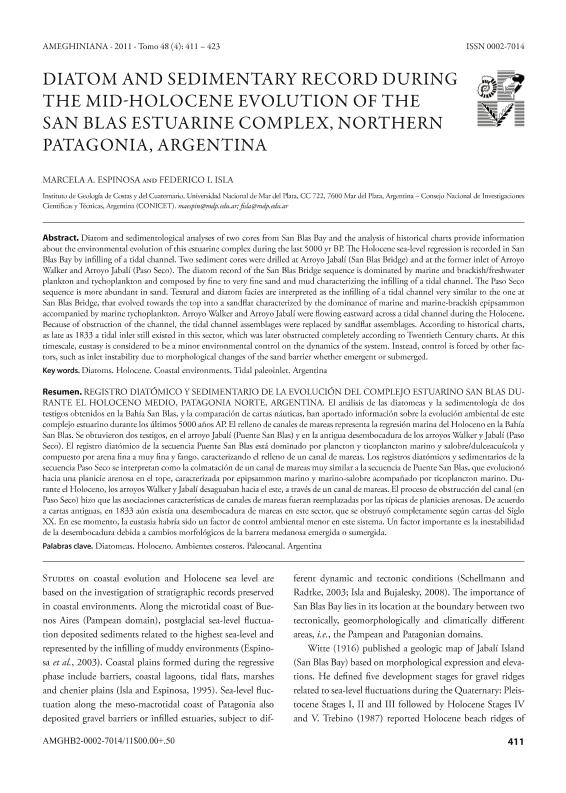Artículo
Diatom and sedimentological analyses of two cores from San Blas Bay and the analysis of historical charts provide information about the environmental evolution of this estuarine complex during the last 5000 yr BP. The Holocene sea-level regression is recorded in San Blas Bay by the infilling of a tidal channel. Two sediment cores were drilled at the Jabalí creek (San Blas Bridge) and at the former inlet of the Walker and Jabalí creeks (Paso Seco). The diatom record of the San Blas Bridge sequence is dominated by marine and brackish/freshwater plankton and tychoplankton and composed by fine to very fine sand and mud characterizing the infilling of a tidal channel. The Paso Seco sequence is more abundant in sand. Textural and diatom facies are interpreted as the infilling of a tidal channel very similar to San Blas Bridge that evolved to the top in a sandflat characterized by the dominance of marine and marine-brackish epipsammon accompanied by marine tychoplankton. Walker and Jabalí creeks were flowing eastward across a tidal channel during the Holocene. Because of the obstruction of the channel the tidal channel assemblages were replaced by sandflat assemblages. According to historical charts, in 1833 still tidal inlet existed in this sector, which obstructed completely according to charts of the 20th century. At this timescale, eustasy is considered to be a minor environmental control on the dynamics of the system. Instead, it is forced by other factors, such as the inlet instability due to morphological changes of the sand barrier, either emerged or submerged. El análisis de las diatomeas y la sedimentología de dos testigos obtenidos en la Bahía San Blas, y la comparación de cartas náuticas, han aportado información sobre la evolución ambiental de este complejo estuarino durante los últimos 5000 años AP. El relleno de canales de mareas representa la regresión marina del Holoceno en la Bahía San Blas. Se obtuvieron dos testigos, en el arroyo Jabalí (Puente San Blas) y en la antigua desembocadura de los arroyos Walker y Jabalí (Paso Seco). El registro diatómico de la secuencia Puente San Blas está dominado por plancton y ticoplancton marino y salobre/dulceacuícola y compuesto por arena fina a muy fina y fango, caracterizando el relleno de un canal de mareas. Los registros diatómicos y sedimentarios de la secuencia Paso Seco se interpretan como la colmatación de un canal de mareas muy similar a la secuencia de Puente San Blas, que evolucionó hacia una planicie arenosa en el tope, caracterizada por epipsammon marino y marino-salobre acompañado por ticoplancton marino. Durante el Holoceno, los arroyos Walker y Jabalí desaguaban hacia el este, a través de un canal de mareas. El proceso de obstrucción del canal (en Paso Seco) hizo que las asociaciones características de canales de mareas fueran reemplazadas por las típicas de planicies arenosas. De acuerdo a cartas antiguas, en 1833 aún existía una desembocadura de mareas en este sector, que se obstruyó completamente según cartas del Siglo XX. En ese momento, la eustasia habría sido un factor de control ambiental menor en este sistema. Un factor importante es la inestabilidad de la desembocadura debida a cambios morfológicos de la barrera medanosa emergida o sumergida.
Diatom and sedimentary record during the mid-holocene evolution of the San Blas estuarine complex: Northern Patagonia, Argentina
Título:
Registro diatómico y sedimentario de la evolución del complejo estuarino San Blas durante el holoceno medio, Patagonia norte, Argentina
Fecha de publicación:
12/2011
Editorial:
Asociación Paleontológica Argentina
Revista:
Ameghiniana
ISSN:
0002-7014
e-ISSN:
1851-8044
Idioma:
Inglés
Tipo de recurso:
Artículo publicado
Clasificación temática:
Resumen
Palabras clave:
Diatomeas
,
Holoceno
,
Ambientes costeros
,
Paleocanal
Archivos asociados
Licencia
Identificadores
Colecciones
Articulos(IIMYC)
Articulos de INSTITUTO DE INVESTIGACIONES MARINAS Y COSTERAS
Articulos de INSTITUTO DE INVESTIGACIONES MARINAS Y COSTERAS
Citación
Espinosa, Marcela Alcira; Isla, Federico Ignacio; Diatom and sedimentary record during the mid-holocene evolution of the San Blas estuarine complex: Northern Patagonia, Argentina; Asociación Paleontológica Argentina; Ameghiniana; 48; 4; 12-2011; 411-423
Compartir




